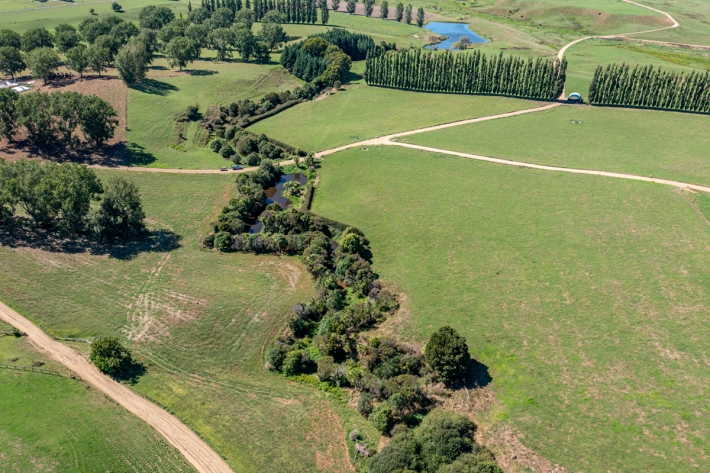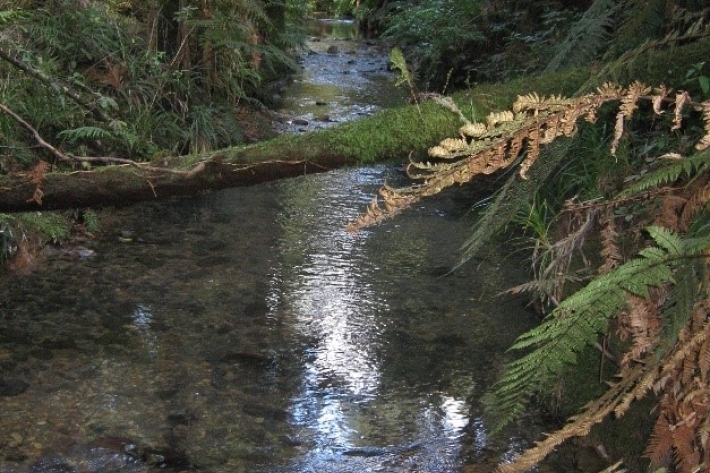Reducing the flow of nutrients, suspended solids and faecal microbes into waterways and providing additional co-benefits by fencing and planting waterways
A riparian buffer is a strip of land which separates agricultural activity from a waterway to remove contaminants through a combination of physical and biological processes. Many livestock farms have invested in riparian buffers, typically a combination of livestock exclusion fencing and planting of native grasses, shrubs, and trees. Riparian buffers also provide several co-benefits including carbon sequestration, shading and water temperature regulation, biodiversity and productive planting opportunities and aesthetic enhancement.
Research update
Our latest research on riparian buffers includes
- Measuring and modelling performance of these systems in collaboration with stakeholders
- Developing tools and guidance to inform best placement of these systems in the landscape, and how to optimise performance.
- Working to ensure that mitigation systems are included in resource limit setting processes and included in integrated catchment models.
Maximising riparian mitigation
Design principles
What do riparian buffers need to do in order to reduce the need for major land use change?
Riparian buffers need to effectively intercept waterflows from the landscape to transform contaminants as they move from land to freshwater environments.
How is this achieved through design?
Contaminants move from land to freshwater via different hydrological flow pathways. Sediment and microbial contaminants are generally mobilized from land in overland flow resulting from rainfall events. Some nutrients are also bound to mobilized sediment or can be transported in overland flow in particulate form. In contrast, dissolved nutrients, including nitrate and phosphate, leach from soils into groundwater and are transported to nearby streams, rivers and lakes as interflow, shallow groundwater, and deep groundwater.
Riparian buffers composed of grasses often do an effective job of trapping sediment in overland flow. Grass buffers will be most effective when the grass sward is dense and well maintained.
Riparian buffers with woody trees and shrubs are best for removing dissolved nutrients from shallow groundwater as their roots extract dissolved nutrients to support growth. The riparian root zone may extend several metres below the ground surface, which increases the extent of groundwater that is intercepted compared with shallow-rooted grasses.
The best riparian buffers are those that combine a grass buffer at the field edge with trees or shrubs closer to the stream, and flexible sedges on the stream margins. This is the basic design that NIWA and industry bodies such as DairyNZ recommend to landowners. The mix of grass and woody vegetation types enables interception of multiple flow pathways. Wetland sedges are recommended for stream margins due to their tolerance to periodic inundation and drag imposed by flood flows.
Including wet spots or wetlands within riparian buffers is also beneficial. Wet organic soils, especially those planted with wetland grasses or sedges may be effective at removing nitrate from water, through plant uptake and a microbial process called denitrification. A slow flow of water through wetland areas is desirable to enhance soil-water contact and the denitrification function. Slow flow also encourages the deposition of sediment and associated contaminants within buffers, which reduces input to the stream.
Protecting wetland areas from disturbance, such as grazing, vehicle crossings, or vegetation removal is recommended to enhance their mitigation functions.
How wide should a buffer be?
Our research indicates that a grass filter width that is about 10% of the length of the hillslope draining to the stream channel is ideal. On average we expect a grass filter of this width to trap about 75% of sediment in runoff and it will also trap nitrogen and phosphorus that are bound to that sediment. Grass filters with a width that is than 10% of hillslope length can also reduce contaminant loads but to a lesser extent – see the Riparian Buffer Design Guide.
Where riparian soils have high clay content (>c. 30%), the effectiveness of riparian buffers to reduce sediment loss to streams is expected to decrease because clay particles will settle less readily than particles with a coarser grain size.
Co-benefits
Carbon sequestration
Riparian buffers can store significant amounts of carbon as the vegetation grows. They do this by removing the greenhouse gas carbon dioxide from the air for photosynthesis.
The best estimates available at present suggests that a 1 ha area of riparian buffer planted in actively growing native shrubs and trees can sequester up to about 5.3 tonnes of carbon dioxide equivalent per year.
Crops that are harvested, or pasture grasses that are grazed sequester little or no carbon because the biomass is removed regularly.
Shading
Dense plantings of trees and shrubs shade streams, which keeps water temperatures cool. This is essential to support aquatic life such as fish and aquatic insects that are vulnerable to thermal stress.
Shade can also reduce the growth of nuisance algae and aquatic weeds and increase the relative abundance of native aquatic plants.
A simple rule of thumb is that riparian plantings should grow to create a dense screen and be as tall as the stream is wide to create enough shade for these benefits. This will create shading of around 70%. The longer the length of stream corridor with riparian planting that creates shade of 70% or more, the more likely it is that water temperatures will be kept cool.
Biodiversity opportunities
Riparian buffers can include a diverse range of native flora, including rare or threatened species. Buffers with native plantings are likely to provide important habitat for native wildlife.
Native sedges on stream margins create bankside cover for fish and all riparian vegetation can provide leaf litter to support stream food webs. Tree branches that periodically fall into streams and rivers provide structural habitat for aquatic life.
Aesthetics
Riparian plantings enhance landscape aesthetics, and, potentially, property values.
Productive buffer concept
Taking land out of production to create effective riparian buffers can be costly but there is potential to generate economic returns from buffers to offset their costs. However, note that some types of productive buffer can have limited carbon sequestration benefits if vegetation is frequently harvested.
Grass filters at field edges can be cut for seasonal silage, or haymaking, if they are accessible. Summer cutting is likely to help reinvigorate grass buffers at a time of year when there is lower risk of runoff, and it will also recycle the nutrients trapped in the grass back into the farm system. Grazing of grass filters by livestock is not recommended as this counteracts the benefits of setting this land aside.
Commercially valuable trees and shrubs can also be used to create productive buffers. Options include planting rewarewa for a honey crop, planting and harvesting willows, poplars, bananas, and some native species such as mahoe for use as fodder crops, and planting totara for timber and essential oil production.
Riparian Buffer Design Guide
Acknowledgements
Development of the riparian buffer design guide and underlying technical reports were funded by MBIE with Strategic Science Investment Funding and with support from DairyNZ. The productive buffer work was completed under subcontract to DairyNZ and funded by Ministry for Primary Industries through the Sustainable Food, Fibre and Futures Fund.
-

Riparian Buffer Design Guide
This guide discusses design principles and provides high-level information about the likely performance of riparian buffers.
Case studies
-

The Whatawhata Integrated Catchment Management Project
Research ProjectThe Whatawhata Integrated Catchment Management (ICM) Project is the longest continuously monitored before-after-control-impact (BACI) catchment-scale study in New Zealand.
Further information
-

Demand grows for NIWA’s Riparian Management Training
Publication article15 September 2022NIWA has updated training materials and restarted a course that explains the use of a riparian planning tool to achieve a range of water quality and environmental outcomes. -

The principles of effective riparian buffer design
Publication article19 January 2023Nutrients, sediment, and microbial contaminants are mobilized from urban and agricultural landscapes and enter streams, rivers, lakes and estuaries.

